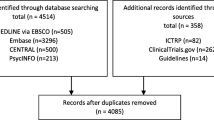Abstract
Many mathematical propositions are expressed in terms of a natural number n for which they are either true or false. This expository paper surveys a collection of propositions P(n) which are true if and only if n ≤ 4.
Similar content being viewed by others
References
R.K. Ahuja, T.L. Magnanti, and J.B. Orlin, Network Flows: Theory, Algorithms and Applications, Prentice-Hall: Englewood Cliffs, NJ, 1993.
K. Appel and W. Haken, “Every planar map is four colorable,” Bulletin of the American Mathematical Society, vol. 82, pp. 711–712, 1976.
E.R. Berlekamp, J.H. Conway, and R.K. Guy, Winning Ways: Games in Particular, vol. 2, Academic Press: London, 1982.
T. Bonnesen and W. Fenchel, Konvexe Körper, Chelsea Publishing Company: New York, 1948.
J.J.A.M. Brands and G. Laman, “Plane section of a tetrahedron,” American Mathematical Monthly, vol. 70, pp. 338–339, 1963.
G. Chartrand and D.P. Geller, “On uniquely colorable planar graphs,” Journal of Combinatorial Theory, vol. 6, pp. 271–278, 1969.
R.W. Cottle, “Minimal triangulation of the 4–cube,” Discrete Mathematics, vol. 40, pp. 25–29, 1982.
R.W. Cottle, J.S. Pang, and R.E. Stone, The Linear Complementarity Problem, Academic Press: Boston, 1992.
H. Davenport, The Higher Arithmetic, 6th edition, Cambridge University Press: Cambridge, 1992.
P.H. Diananda, “On nonnegative forms in real variables some or all of which are nonnegative,” Proceedings of the Cambridge Philosophical Society, vol. 58, pp. 17–25, 1962.
G.A. Dirac and S. Schuster, “A theorem of Kuratowski,” Indagationes Mathematicae, vol. 16, pp. 343–348, 1954.
H.G. Eggleston, “Plane section of a tetrahedron,” American Mathematical Monthly, vol. 70, p. 1108, 1963.
P. Erdös, A. Goodman, and L. Pósa, “The representation of a graph by set intersections,” Canadian Journal of Mathematics, vol. 18, pp. 106–112, 1966.
R.E. Erickson, C.L. Monma, and A.F. Veinott, Jr., “Send-and-split method for minimum-concave-cost network flows,” Mathematics of Operations Research, vol. 12, pp. 634–664, 1987.
H. Eves, An Introduction to the History of Mathematics, Rinehart: New York, 1953.
J. Faraut and A. Korányi, Analysis on Symmetric Cones, Oxford University Press: New York, 1994.
F. Granot and A.F. Veinott, Jr., “Substitutes, complements and ripples in network flows,” Management Science, vol. 10, pp. 471–497, 1985.
H.W. Guggenheimer, Applicable Geometry, Robert E. Krieger Publishing Company, Inc.: Huntington, 1977.
M. Hall, “A problem in partitions,” Bulletin of the American Mathematical Society, vol. 47, pp. 804–807, 1941.
M. Hall, Jr., “A survey of combinatorial analysis,” in Some Aspects of Analysis and Probability, Surveys in Applied Mathematics IV, I. Kaplansky, M. Hall, Jr., E. Hewitt, and R. Fortet (Eds.), John Wiley & Sons: New York, 1958, pp. 35–104.
M. Hall, Jr., Combinatorial Theory, Blaisdell: Waltham, MA, 1967.
M. Hall, Jr. and M. Newman, “Copositive and completely positive quadratic forms,” Proceedings of the Cambridge Philosophical Society, vol. 59, pp. 329–339, 1963.
F. Hausdorff, “Der Wertvorrat einer Bilinearform,” Mathematische Zeitschrift, vol. 3, pp. 314–316, 1919.
P. Heawood, “Map color theorems,” Quarterly Journal of Mathematics, vol. 24, pp. 332–338, 1890.
R. Honsberger, “A problem in checker-jumping,” Mathematical Gems II, Mathematical Association of America: Washington, D.C., 1976, pp. 23–28.
R.A. Horn and C.R. Johnson, Matrix Analysis, Cambridge University Press: Cambridge, 1985.
R.A. Horn and C.R. Johnson, Topics in Matrix Analysis, Cambridge University Press: Cambridge, 1991.
C. Kuratowski, “Sur le probleme des courbes gauches en topologie,” Fundamenta Mathematicae, vol. 15–16, pp. 271–283, 1930.
J.L. Lagrange, “Réflexions sur la résolution algébrique des équations,” Oevres, vol. 3, pp. 207–421. (From a paper of 1771.)
A.-M. Legendre, Théorie des Nombres, F. Didot: Paris, 1830.
C.E. Lemke, “Bimatrix equilibrium points and mathematical programming,” Management Science, vol. 11, pp. 681–689, 1965.
O. Ore, Theory of Graphs, American Mathematical Society: Providence, RI, 1962.
O. Ore, The Four-Color Problem, Academic Press: New York, 1967.
J.R. Maxfield and H. Minc, “On the matrix equation X′X = A,” Proceedings of the Edinburgh Mathematical Society, vol. 13:2, pp. 125–129, 1962–1963.
A. Meyer, “Mathematische Mittheilungen,” Vierteljahrschrift der Naturforschenden Gesellschaft in Zürich, vol. 29, pp. 209–222, 1884.
L.J. Mordell, Diophantine Equations, Academic Press: New York, 1969.
T.S. Motzkin, Beitrage zur Theorie der linearen Ungleichungen (Inaugural dissertation, Basel), Azriel: Jerusalem, 1936.
T.S. Motzkin, in National Bureau of Standards Report 1817, pp. 11–12, 1952.
B.N. Moyls and M.D. Marcus, “Field convexity of a square matrix,” Proceedings of the American Mathematical Society, vol. 6, pp. 981–983, 1955.
T. Nagell, Introduction to Number Theory, John Wiley & Sons: New York; Almqvist & Wiksell: Stockholm, 1951.
O.T. O'Meara, Introduction to Quadratic Forms, Springer-Verlag: Berlin, 1963.
J. Philip, “Plane sections of simplices,” Mathematical Programming, vol. 3, pp. 312–325, 1972.
K.W. Schmidt, “Problem 68–18, Binary matrices,” SIAM Review, vol. 13, pp. 119–121, 1971.
D.E. Smith, History of Mathematics, vol. I, Dover: New York, 1951.
D.M.Y. Sommerville, An Introduction to the Geometry of N Dimensions, Dover: New York, 1958.
E. Szpilrajn-Marczewski, “Sur deux propriétés des classes d'ensembles,” Fundamenta Mathematicae, vol. 33, pp. 303–307, 1945.
L. Toti Rigatelli, Evariste Galois, Birkhäuser: Basel, 1996.
A.F. Veinott, Jr., “Least d-majorized network flows with inventory and statistical applications,” Management Science, vol. 17, pp. 547–567, 1971.
E.B. Vinberg, “Homogeneous cones,” Soviet Mathematics Doklady, vol. 1, p. 787, 1960.
E.B. Vinberg, “The theory of convex homogeneous cones,” Transactions of the Moscow Mathematical Society (1963), 1965, pp. 340–403.
E.B. Vinberg, private communication, May 5, 1968.
B.L. van der Waerden, Modern Algebra, vol. I, Ungar: New York, 1949.
D.W. Walkup, “A simplex with a large cross-section,” American Mathematical Monthly, vol. 75, pp. 34–36, 1968.
R. Webster, Convexity, Oxford University Press: Oxford, 1994.
C. Zong, Strange Phenomena in Convex and Discrete Geometry, Springer-Verlag: New York, 1996.
Author information
Authors and Affiliations
Rights and permissions
About this article
Cite this article
Cottle, R.W. Quartic Barriers. Computational Optimization and Applications 12, 81–105 (1999). https://doi.org/10.1023/A:1008615713732
Issue Date:
DOI: https://doi.org/10.1023/A:1008615713732




